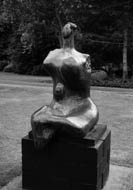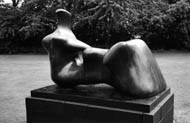In July 2005, I went on safari to South Africa. In order to break up the journey, I stopped in London while going to and returning from Johannesburg. The most important part of this London hiatus was an all-day visit to Henry Moore’s studio/foundation, about half way between London and Cambridge.
After determining my travel dates, I contacted the keeper of the grounds and works of art at Perry Green, the property bought and expanded by Moore following World War II. The foundation was gracious in giving me a reservation for the daily public tour of the grounds and in arranging for my viewing of the inner workings of the facility.
The train trip from London’s Liverpool Street Station was a relaxing 40 minutes through green pastures and crop fields separated by hedges and stonewalls, interrupted occasionally by English towns and hamlets. Upon arriving in Bishop’s Stortford, a 10-minute taxi ride deposited me at the front door of the Henry Moore Foundation in Much Haddam, a small rural village. The foundation offices are located next door to the Moore family house.
I was enthusiastically welcomed to a modern one-story stucco and glass building, and invited to morning coffee with the staff of about 10. They continue the Moores’ tradition of breaking at mid-morning for coffee, sweets and socializing. After coffee, my tour of the private collection of maquettes and drawings and a thorough explanation of the Henry Moore Foundation library were conducted by an informative and friendly Michael Phipps. Imagine - an entire room filled with shelves of maquettes and models of sculptures that I’ve seen in person or in books of the artist’s work. And, in addition, original sketches and drawings, some of them sculptural precursors to subsequent sculptures and others of two-dimensional scenes, such as the “tube drawings” from World War II.
The library of the foundation is housed in a separated small building and contains 1) articles and books written about Moore, 2) writings and letters by Moore, 3) videos and tapes about Moore, and 4) most of the books, magazines and newspapers that Moore collected about art. The collection is open to scholars and researchers, and the collection grows as people send pertinent materials to the foundation.
The end of the private tour was the restoration laboratory, where all of Moore’s sculptures are cleaned, repaired and restored by a capable staff of three. The head of this department is an accomplished stone sculptor, who has several of his own pieces scattered around the studio. This team prepares the pieces for all shows internationally, crates and ships them, and then sets up the show. They reverse the process when the show ends. Major repairs are performed on the grounds of the foundation. One monumental fiberglass piece was being repaired extensively during my visit, because it had suffered damage to the fiberglass shell, and the wooden internal bracing had rotted from water exposure.
The lunch hour is adhered to, so I adjourned to Hoops Inn, an ancient village pub across the street from Perry Green for a sandwich and a pint of bitter. Because of the overload of information and visual stimulation, the quiet hour was welcomed.
After lunch, the public tour of the grounds commenced. The group tours are led by volunteer docents well-steeped in the life and works of Moore. The tour costs 7 pounds ($14), and you must have a reservation (easily obtained by email). Due to an agreement between Moore’s daughter and the Henry Moore Foundation, only a limited number of visitors are allowed on the grounds each year, tour sizes and dates are limited. Guests come from all over the world to this small hamlet; the big three are the U.S., Japan and Canada.
Large to monumental bronze sculptures are scattered artfully around the fields and lawns that stretch behind the Moore residence and foundation buildings. Trees and shrubs break up the grounds into small and large spaces, some with mown lawns, some with long grass, and one large pasture. The most striking are two pieces that are situated in a sheep pasture, around which the flock moves.
The maquette studio is maintained just as it was when Moore worked there, and includes not only his carved and molded clay and plaster models, but also the bones, shells and found rocks that he accumulated for inspiration. Of particular significance were the elephant and rhinoceros skulls given to him by Aldus Huxley.
At the time of my visit, the exhibition studio was showing “Moore and Architecture”; how Moore’s sculptures influence the structures into which they were placed, and how architecture influenced his art. The modern, two-story building contained drawings, maquettes, small sculptures and photographs of his work in bronze, stone, and wood.
At the completion of the group tour, I made my way back to the foundation library, where I traded stories with another sculptor and browsed the library holdings, particularly the books that Henry Moore collected himself, until closing at 5:00.
Back in Bishop’s Stortford, a pint of Guinness at an archetypical English pub helped gel my rampant thoughts of the day and record the images in words.

One day in August, a dream was consummated for me - a long-time admirer and student of a great and prolific artist. From humble beginnings, Moore built a lucrative and satisfying career, meanwhile helping to revolutionize three-dimensional shapes, or perhaps put them back where they belong; in ‘primitive’ forms.
The Henry Moore Foundation can be reached at 01279-843333 or www.henry-moore-fdn.co.uk or The Henry Moore Foundation, Dane Tree House, Perry Green, Much Haddam, Hertfordshire SG106EE, United Kingdom

